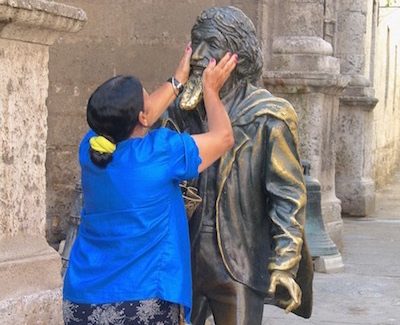Shore Excursion: Statue in Havana, Cuba, honors ‘crazy’ man
Cuba is a country of statues and monuments, many of them dedicated to heroes of the revolution. But one unusual bronze figure in Havana is the only one in the world I have seen for a certifiably crazy person.
On a walking tour of Havana, we stopped in front of a church. However, what caught my attention was a statue outside the church of a man whose beard, left index finger and foot have been polished almost golden from the touch of passersby.
Tour guide Isora said the statue is of the so-called Caballero de Paris (Gentleman from Paris). The life-size statue shows a thin man with scruffy and abundant hair and beard, carrying some papers, pencils and a satchel. Despite the strong Cuban sun, he wears a suit coat, necktie and black cape.
The man was a popular street character in Havana in the 1950s, Isora said. “He was very good to the poor and would talk to anyone who would listen to him,” Isora said. “People loved him.”
Facts are a bit sketchy but the man whose true name was José María López Lledín was born in Lugo, Spain, in 1899 and had never been to Paris or to France. He came to Cuba seeking his fortune when he was 12 years old. He worked at many jobs, mainly in hotels, restaurants, shops and even a law office.
In 1920, Lledín was thrown in prison for a crime he was later found not to have committed. Details of that crime are not clear but some say it was the theft of jewels from a home, others say he was framed by a jealous husband.
For whatever reason, Lledín was imprisoned for six years. During that time, he would proclaim that he was a knight or a French musketeer or royal personage who was innocent and needed to be set free.
When he was finally released, his mind was gone. He wandered the streets, never begging or being violent. If someone did give him money or food, the Gentleman from Paris would give that person something in return – a sketch he had made or some pencil stubs wrapped in different-colored threads.
Intelligent and well educated, Lledín loved to talk about life, religion, politics and news of the day. He never cursed and was said to be a welcome sight even to small children who might have been expected to shy away from his strange appearance.
For almost half a century, Lledín roamed the streets of Havana. He was known for his good manners, dignity, kindness and eloquence – although his speeches were sometimes nonsensical because of his mental condition.
When he was arrested once by authorities for being a vagrant, there was so much public uproar that he was released. On another occasion in the 1940s when he was hauled off to a psychiatric hospital, an order from former Cuban president Batista returned him to the streets.
As he grew older and became quite frail, a sympathetic doctor persuaded the Gentleman to enter a psychiatric hospital. Treated with respect and diagnosed with a form of schizophrenia, Lledín lived there until his death eight years later on July 12, 1985.
His doctor, Dr. Luis Calzadilla, assistant director at the Havana Psychiatric Hospital, wrote a book about Lledín. The Gentleman also was interviewed several times by Cuban newspapers and TV stations and had a musical written about his life.
The statue by sculptor José Villa Soberón was erected in 2001. Legends and superstitions soon followed. It is said that those who touch his beard, hand and foot will be blessed with good luck. A tour guide standing near me told his group that those who grasp his beard and make a wish to return to Cuba will have that wish granted.
The tour guide also said that when Cuban girls turn 15 and celebrate with a big quinceanera party, they often show up by the statue in their regal rented gowns to be photographed with him and to wish for a good husband and happy adult life.
It was difficult to get a photo of the statue without someone next to it because whenever one person would walk off, it seemed as though another would walk up. As I was getting ready to leave, an elderly woman walked up with the help of a metal folding cart. She proceeded to caress the statue’s face, talking all the while to him in Spanish. A tour guide said the woman pays a visit almost every day and often will wipe off the statue’s face with a cloth.
The guide also told me that the Gentleman from Paris has been compared to an emissary from God, that those who were kind to him as he wandered this earth were showing their love for their heavenly Father.
What the Gentleman from Paris valued most, the guide said, was his freedom. Perhaps, that is why his legacy continues to live so strongly in the Communist country of Cuba where freedom seems to be a difficult-to-attain treasure.
Story and Photo by Jackie Sheckler Finch















View Recent Comments